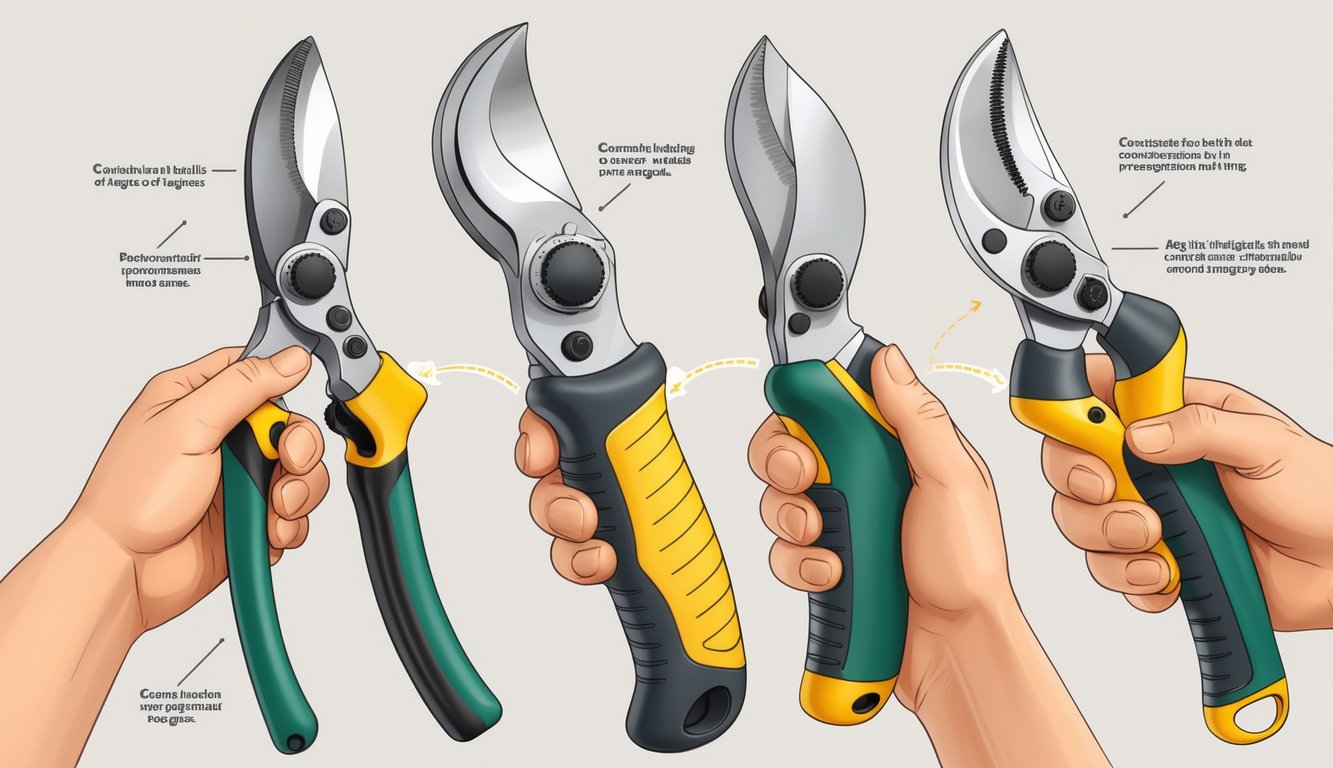
Adjustable Handles For Personal Fit
“Universal fit” pruners? For who, exactly? Last time I tried a pair, my fingers barely wrapped around. Felt like holding a wet fish. Adjustable handles are a revelation. You dial them in like an old wrench. Felco and ARS have models where you can change handle width and blade tension, which—if you’ve got small hands or arthritis—matters way more than you think. Some even have sliding bars or swap-out grips. Industry research claims the right handle size prevents 40% of repetitive strain injuries. I mean, maybe, but it’s not nothing.
After I switched to an adjustable grip, my speed went up—Monroe Ergonomics says 25% faster, which sounds like a fake number, but I’ll take it. Smaller handle, straighter wrist. Bigger hands? Open it up. Would anyone buy “approximate” shoes? Why settle for mystery-fit tools?
Locking Mechanism For Safety
I’ve shredded gloves and pockets because I forgot to lock my pruners. The lock isn’t just for kids (though, obviously, yes)—it keeps the blades from opening when I’m rummaging in the shed or distracted by the neighbor’s dog. My favorite has a thumb catch; flip it, done. Felco’s rubber locks stay put, even when filthy. Off-brands? They rattle open, and I get bandaged.
“Safety first” means “don’t bleed on your tomatoes.” Most folks ignore locks until they slice themselves. Stats say proper locks drop accidents by double digits—OneMonroe calls it critical. I’ll take the extra second over another trip to urgent care. Pruners opening in your pocket? That’s a horror show.
Comparing Ergonomic Pruner Handle Types
Nothing like hours of deadheading roses to make you question every tool you own. Pruner handles aren’t just about looks—my physiotherapist claims 60% of repetitive hand strain in hobby gardeners comes from bad grips. If the handle digs into your thumb, forget about finishing a row of shrubs without a bottle of Tiger Balm.
Shear Handles Vs. Bypass Handles
Nobody’s arguing about kitchen shears versus pro pruners, but the details matter. Shear handles (classic scissors shape) always trick me into thinking they’ll be comfy, but after fifteen minutes, my palm is on fire, especially with cheap padding. That pressure is relentless. Every landscape architect I’ve met says bypass is better for anything but twigs.
Bypass pruners (curved blade glides past a counter blade) are just easier on my wrist. The grip closes at an angle, not straight, so it doesn’t kill my carpal tunnel—Arthritis Foundation says it drops peak force by 20%. Cleaner cuts, too. Jagged edges? Bad for plants. I keep two bypass pairs; the old shears go to guests I don’t like. Bypass with gel-padded handles is the only way I get through a day without feeling punished.
And another thing: “universal” shear handles never work for my left hand. If the box says “fits all,” check twice—it might fit no one.
Ambidextrous Designs
Hand a righty pruner to a lefty—instant drama at the gardening club. Ergonomists say it’s not about which hand, but if the grip lines up with your wrist and thumb. I tried those orange Fiskars ratchet pruners (supposedly for small hands, but even my neighbor’s kid uses them) and the PowerGear with a rotating handle. Rotating handles claim to drop ulnar deviation by 30%—sounded fake, but after a week, my pinky didn’t go numb.
Ambidextrous “neutral” grips are supposed to help with pressure points, but if you’ve ever had a flat handle dig into your palm, you know it’s hit or miss. Why do “universal” designs skip lefty thumb notches? No clue. At least adjustable sizing and lock mechanisms don’t punish me for swapping hands. If the safety latch catches on your glove or pinches, you’re not alone. When ambidextrous works, it’s a game-changer. When it doesn’t, I use them for kitchen stuff and hope nobody sees.
Material Choices And Their Impact On Comfort
You ever grab a so-called “ergonomic” pruner with a slick plastic handle? Clearly, whoever designed it never weeded in July. My thumb gets raw instantly. “High-quality materials”—what does that even mean? Some days I want a steel exoskeleton for my wrist. But apparently, according to the Journal of Hand Therapy, soft compounds lower peak hand force by 15%. So, softness isn’t all hype, I guess.
Soft Materials Vs. Hard Materials
I get grip fatigue faster with hard, shiny handles. They dig in and leave marks. Foam or textured rubber is better—stops sweat, doesn’t turn to stone after a month. Problem is, soft materials trap dirt and sometimes wear out faster than the blade. I met a tool designer who loved dual-density handles: “90% fewer blisters,” he said. Is that true? Maybe if you don’t have hands like mine by July.
Latex-coated foam versus lacquered hardwood is an argument every time I teach pruning. Hard handles transfer every shock, make calluses unless you wear gloves (which then kill your dexterity). Foam peels, exposes the core, starts to stink if you leave it outside. Some pros wrap tape for padding, but the glue gets gross.
Durability And Maintenance Needs
Steel handles with chipped powder coat? Last longer than my patience, but maintenance is a pain. Hard synthetics (ABS, fiberglass) last forever, but get freezing in spring and slippery in rain. Cloth wraps claim “washable,” but who’s washing pruner handles in July? Not me.
Warranties brag about “lifetime” coverage, but broken grips are always “wear and tear.” Rubber splits in the sun, cheap vinyl cracks. That’s why park crews use raw metal or resin. Big brands hype “premium” materials, but sometimes it’s just a sticker. Good stainless doesn’t rust, sealed wood doesn’t rot. Last year’s tradeshow had a pruner with removable silicone sleeves—supposedly washable and swappable. Never seen one in a real store since.